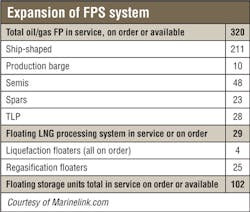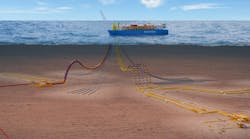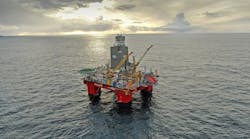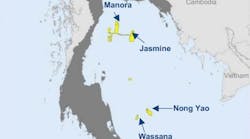Sue Wang
ABS
Over the years,mooring systems have evolved to meet the industry's demands for increased station-keeping capability and reliability. Mooring components such as chain, ropes, and connectors are being designed larger and constructed using new materials. In deeper water and harsher conditions, turret mooring, disconnectable and thruster-assisted systems are improving station-keeping capability. But as these systems expand in complexity, a wider range of operational considerations must be taken into account.
New components require extensive design verification and will in some cases present installation and operational challenges. Another issue that needs to be addressed is how best to inspect and maintain the equipment. In addition, there is uncertainty about the corrosion characteristics of some of the new components, with a lack of in-service data available to determine their long-term performance.
Mooring system components that have suffered failures include the chain or wire rope, polyester rope, connectors, and the yoke column. When damage occurs, the entire asset can be compromised. ABS is participating in numerous industry research initiatives that are looking for solutions to these problems.
One recently concluded program focused on floating production system mooring integrity, while another targeted seawater corrosion on rope and chain. In a third, engineers examined chain out-of-plane bending and mooring components. In this case, the focus was on a range of connectors as well as subsea components, with the goal of determining methods of identifying potential failures arising from defects, fatigue, and fractures.
In an ongoing research program, engineers are evaluating techniques that can be used to monitor structural integrity. Verifying integrity is an enormous challenge because it is so difficult to monitor performance when a huge amount of the equipment is below the water surface and – in the case of the moorings – extends for many miles.
Another project that started earlier this year is addressing the impact of extreme cold on steel components. The goal is to develop a design and operation practice document based on existing technology, industry experience, and consensus building. Such a document would serve as a foundation for developing industry standards (such as an Arctic supplement to API RP 2SK) as well as company-specific design and operation guidelines.
There is information to draw on from operating experience between the 1970s and 1990s, including the Kulluk report, which contains valuable information on station keeping for floating drilling in the Arctic and is the only document that provides full-scale data for loads from managed ice on a floating structure. In the future, additional data will come from the Shtokman FPU mooring system designed for use inRussia's portion of the Barents Sea, the disconnectable mooring systems on the Terra Nova and SeaRose FPSOs working offshore eastern Canada, and numerous technical papers.
ABS researchers involved in another ongoing program are focusing on the fatigue performance of mooring chains in sea water. With larger chains being used increasingly in mooring systems, there is a need to improve on the fatigue curves that have historically been developed based on performance data from smaller chains with different physical characteristics. One of this project's goals is to evaluate a finite element analysis approach to determining fatigue.
Improving guidance
ABS engages in individual and joint research projects. It aims to use the results to improve its Rules and Guides for safety, design verification, construction survey, and periodic surveys to validate continued safe performance. The practical and impartial nature of these regularly updated and improved documents is intended to help the industry design, deploy, and maintain safer mooring systems.
There have been updates to the ABS Guidance Notes for the Application of Fiber Rope for Offshore Mooring and the Guide for the Certification of Offshore Mooring Chain. And guidelines are being developed to incorporate industry advancements and recommendations from recent mooring-related joint industry projects. Moving forward, specific focus areas include:
• Integrity of mooring systems, considering failure mode assessment and weak links in mooring systems, focusing on redundancy, operations manuals, and system monitoring
• Mooring systems operating in proximity to other assets
• Mooring system performance in squalls
• Mooring systems in ice
• Mooring chain life extension.
Addressing advances in DP technology
Today, dynamic position (DP) capability is considered almost standard for deepwater drilling newbuilds, and it is no longer unusual to see offshore support vessels and shuttle tankers outfitted with DP systems. Nearly 80% of the newly built MODUs in the market today have DP systems, and the industry has come to rely on this capability.
However, when operations move into new areas and technologies change in application and usage, class societies have to re-assess how the technical standards they develop are of benefit to the industry. The ABS Guide for Dynamic Positioning Systems provides requirements for the design, testing, and surveying of DP systems. It also addresses current DP needs and provides optional notations, including Enhanced System (EHS) notations and Station Keeping Performance (SKP) notations.
The notations that denote features of the DP system allow owners and operators to differentiate among systems and their capabilities, and they provide information that makes it easier to select the correct system. Failed DP systems can compromise operations and, in the worst-case scenarios, lead to pollution events or spills, or in some cases endanger offshore personnel.






